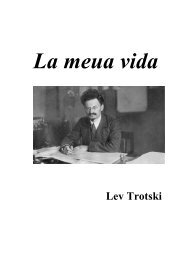get, and vice versa. Whenever a quantity is given, one part <strong>of</strong> it will increase inversely as theother decreases. If the wages change, pr<strong>of</strong>its will change in an opposite direction. If wages fall,pr<strong>of</strong>its will rise; and if wages rise, pr<strong>of</strong>its will fall. If the working man, on our formersupposition, gets three shillings, equal to one half <strong>of</strong> the value he has created, or if his wholeworking day consists half <strong>of</strong> paid, half <strong>of</strong> unpaid labour, the rate <strong>of</strong> pr<strong>of</strong>it will be 100 percent,because the capitalist would also get three shillings. If the working man receives only twoshillings, or works only one third <strong>of</strong> the whole day for himself, the capitalist will get fourshillings, and the rate <strong>of</strong> pr<strong>of</strong>it will be 200 per cent. If the working man receives four shillings,the capitalist will only receive two, and the rate <strong>of</strong> pr<strong>of</strong>it would sink to 50 percent, but all thesevariations will not affect the value <strong>of</strong> the commodity. A general rise <strong>of</strong> wages would, therefore,result in a fall <strong>of</strong> the general rate <strong>of</strong> pr<strong>of</strong>it, but not affect values.But although the values <strong>of</strong> commodities, which must ultimately regulate their market prices, areexclusively determined by the total quantities <strong>of</strong> labour fixed in them, and not by the division <strong>of</strong>that quantity into paid and unpaid labour, it by no means follows that the values <strong>of</strong> the singlecommodities, or lots <strong>of</strong> commodities, produced during twelve hours, for example, will remainconstant. The number or mass <strong>of</strong> commodities produced in a given time <strong>of</strong> labour, or by a givenquantity <strong>of</strong> labour, depends upon the productive power <strong>of</strong> the labour employed, and not upon itsextent or length. With one degree <strong>of</strong> the productive power <strong>of</strong> spinning labour, for example, aworking day <strong>of</strong> twelve hours may produce twelve pounds <strong>of</strong> yarn, with a lesser degree <strong>of</strong>productive power only two pounds. If then twelve hours' average labour were realized in thevalue <strong>of</strong> six shillings in the one case, the twelve pounds <strong>of</strong> yarn would cost six shillings, in theother case the two pounds <strong>of</strong> yarn would also cost six shillings. One pound <strong>of</strong> yarn would,therefore, cost sixpence in the one case, and three shillings in the other. The difference <strong>of</strong> pricewould result from the difference in the productive powers <strong>of</strong> labour employed. One hour <strong>of</strong>labour would be realized in one pound <strong>of</strong> yarn with the greater productive power, while with thesmaller productive power, six hours <strong>of</strong> labour would be realized in one pound <strong>of</strong> yarn. The price<strong>of</strong> a pound <strong>of</strong> yarn would, in the one instance, be only sixpence, although wages were relativelyhigh and the rate <strong>of</strong> pr<strong>of</strong>it low; it would be three shillings in the other instance, although wageswere low and the rate <strong>of</strong> pr<strong>of</strong>it high. This would be so because the price <strong>of</strong> the pound <strong>of</strong> yarn isregulated by the total amount <strong>of</strong> labour worked up in it, and not by the proportional division <strong>of</strong>that total amount into paid and unpaid labour. The fact I have mentioned before that high-pricelabour may produce cheap, and low-priced labour may produce dear commodities, loses,therefore, its paradoxical appearance. It is only the expression <strong>of</strong> the general law that the value<strong>of</strong> a commodity is regulated by the quantity <strong>of</strong> labour worked up in it, and the the quantity <strong>of</strong>labour worked up in it depends altogether upon the productive powers <strong>of</strong> labour employed, andwill therefore, vary with every variation in the productivity <strong>of</strong> labour.XIII. Main Cases <strong>of</strong> Attempts at Raising Wages or Resistingtheir FallLet us now seriously consider the main cases in which a rise <strong>of</strong> wages is attempted or areduction <strong>of</strong> wages resisted.1. We have seen that the value <strong>of</strong> the labouring power, or in more popular parlance, the value <strong>of</strong>labour, is determined by the value <strong>of</strong> necessaries, or the quantity <strong>of</strong> labour required to producethem.If, then, in a given country the value <strong>of</strong> the daily average necessaries <strong>of</strong> the labourer representedsix hours <strong>of</strong> labour expressed in three shillings, the labourer would have to work six hours dailyto produce an equivalent for this daily maintenance. If the whole working day was twelve hours,the capitalist would pay him the value <strong>of</strong> his labour by paying him three shillings. Half theworking day would be unpaid labour, and the rate <strong>of</strong> pr<strong>of</strong>it would amount to 100 percent. Butnow suppose that, consequent upon a decrease <strong>of</strong> productivity, more labour should be wanted toproduce, say, the same amount <strong>of</strong> agricultural produce, so that the price <strong>of</strong> the average dailynecessaries should rise from three to four shillings. In that case the value <strong>of</strong> labour would rise byone third, or 33 1/3 percent. Eight hours <strong>of</strong> the working day would be required to produce anequivalent for the daily maintenance <strong>of</strong> the labourer, according to his old standard <strong>of</strong> living. Thesurplus labour would therefore sink from six hours to four, and the rate <strong>of</strong> pr<strong>of</strong>it from 100 to 50percent. But in insisting upon a rise <strong>of</strong> wages, the labourer would only insist upon getting the
increased value <strong>of</strong> his labour, like every other seller <strong>of</strong> a commodity, who, the costs <strong>of</strong> hiscommodities having increased, tries to get its increased value paid. If wages did not rise, or notsufficiently rise, to compensate for the increased values <strong>of</strong> necessaries, the price <strong>of</strong> labourwould sink below the value <strong>of</strong> labour, and the labourer's standard <strong>of</strong> life would deteriorate.But a change might also take place in an opposite direction. By virtue <strong>of</strong> the increasedproductivity <strong>of</strong> labour, the same amount <strong>of</strong> the average daily necessaries might sink from threeto two shillings, or only four hours out <strong>of</strong> the working day, instead <strong>of</strong> six, be wanted toreproduce an equivalent for the value <strong>of</strong> the daily necessaries. The working man would now beable to buy with two shillings as many necessaries as he did before with three shillings. Indeed,the value <strong>of</strong> labour would have sunk, but diminished value would command the same amount <strong>of</strong>commodities as before. Then pr<strong>of</strong>its would rise from three to four shillings, and the rate <strong>of</strong> pr<strong>of</strong>itfrom 100 to 200 per cent. Although the labourer's absolute standard <strong>of</strong> life would have remainedthe same, his relative wages, and therewith his relative social position, as compared with that <strong>of</strong>the capitalist, would have been lowered. If the working man should resist that reduction <strong>of</strong>relative wages, he would only try to get some share in the increased productive powers <strong>of</strong> hisown labour, and to maintain his former relative position in the social scale. Thus, after theabolition <strong>of</strong> the Corn Laws, and in flagrant violation <strong>of</strong> the most solemn pledges given duringthe anti-corn law agitation, the English factory lords generally reduced wages ten per cent. Theresistance <strong>of</strong> the workmen was at first baffled, but, consequent upon circumstances I cannot nowenter upon, the ten per cent lost were afterwards regained.2. The values <strong>of</strong> necessaries, and consequently the value <strong>of</strong> labour, might remain the same, buta change might occur in their money prices, consequent upon a previous change in the value <strong>of</strong>money. By the discovery <strong>of</strong> more fertile mines and so forth, two ounces <strong>of</strong> gold might, forexample, cost no more labour to produce than one ounce did before. The value <strong>of</strong> gold wouldthen be depreciated by one half, or fifty per cent. As the values <strong>of</strong> all other commodities wouldthen be expressed in twice their former money prices, so also the same with the value <strong>of</strong> labour.Twelve hours <strong>of</strong> labour, formerly expressed in six shillings, would now be expressed in twelveshillings. If the working man's wages should remain three shillings, instead <strong>of</strong> rising to sixshillings, the money price <strong>of</strong> his labour would only be equal to half the value <strong>of</strong> his labour, andhis standard <strong>of</strong> life would fearfully deteriorate. This would also happen in a greater or lesserdegree if his wages should rise, but not proportionately to the fall in the value <strong>of</strong> gold. In such acase nothing would have been changed, either in the productive powers <strong>of</strong> labour, or in supplyand demand, or in values.Nothing could have changed except the money names <strong>of</strong> those values. To say that in such a casethe workman ought not to insist upon a proportionate rise <strong>of</strong> wages, is to say that he much becontent to be paid with names, instead <strong>of</strong> with things. All past history proves that whenever sucha depreciation <strong>of</strong> money occurs, the capitalists are on the alert to seize this opportunity fordefrauding the workman. A very large school <strong>of</strong> political economists assert that, consequentupon the new discoveries <strong>of</strong> gold lands, the better working <strong>of</strong> silver mines, and the cheapersupply <strong>of</strong> quicksilver, the value <strong>of</strong> precious metals has again depreciated. This would explainthe general and simultaneous attempts on the Continent at a rise <strong>of</strong> wages.3. We have till now supposed that the working day has given limits. The working day, however,has, by itself, no constant limits. It is the constant tendency <strong>of</strong> capital to stretch it to its utmostphysically possible length, because in the same degree surplus labour, and consequently thepr<strong>of</strong>it resulting therefrom, will be increased. The more capital succeeds in prolonging theworking day, the greater the amount <strong>of</strong> other peoples' labour it will appropriate.During the seventeenth and even the first two thirds <strong>of</strong> the eighteenth century a ten hoursworking day was the normal working day all over England. During the anti-Jacobin war, whichwas in fact a war waged by the British barons against the British working masses, capitalcelebrated its bacchanalia, and prolonged the working day from ten to twelve, fourteen, eighteenhours. Malthus, by no means a man whom you would suspect <strong>of</strong> a maudlin sentimentalismdeclared in a pamphlet, published about 1815, that if this sort <strong>of</strong> thing was to go on the life <strong>of</strong>the nation would be attacked at its very source. A few years before the general introduction <strong>of</strong>newly-invented machinery, about 1765, a pamphlet appeared in England under the title, AnEssay On Trade. The anonymous author, an avowed enemy <strong>of</strong> the working classes, declaims onthe necessity <strong>of</strong> expanding the limits <strong>of</strong> the working day. Amongst other means to this end, he
- Page 4:
égime, which has been through its
- Page 7:
sins of all state forms. That this
- Page 13 and 14:
It has not occurred to any one of t
- Page 15 and 16:
gradually accumulated small capital
- Page 17 and 18:
from this nonsensical ‘prehistory
- Page 19 and 20:
property: the nucleus, the first fo
- Page 21 and 22:
which produces in all nations simul
- Page 23 and 24:
[8. The Inconsistency of the Ideali
- Page 25 and 26:
The ‘essence’ of the fish is it
- Page 27 and 28:
hence of the relationships which ma
- Page 29 and 30:
labour. In the first case, therefor
- Page 31 and 32:
production and commerce soon calls
- Page 33 and 34:
period begins with the Navigation L
- Page 35 and 36:
more advanced countries, still have
- Page 37 and 38:
over against the individuals, so th
- Page 39 and 40:
eality is only a product of the pre
- Page 41 and 42:
never became more than a city; its
- Page 43 and 44:
Only at this stage does self-activi
- Page 45 and 46:
Modern industry has established the
- Page 47 and 48:
these crises, there breaks out an e
- Page 49 and 50:
Further, as we have already seen, e
- Page 51 and 52:
abolish that; the development of in
- Page 53 and 54:
For the rest, nothing is more ridic
- Page 55 and 56: III. Socialist and Communist Litera
- Page 57 and 58: conscious of having overcome “Fre
- Page 59 and 60: The undeveloped state of the class
- Page 61 and 62: The Paris CommuneAddress to the Int
- Page 63 and 64: priests were sent back to the reces
- Page 65 and 66: pregnant. In the full consciousness
- Page 67 and 68: subjected Versailles and the rest o
- Page 69 and 70: The Eighteenth Brumaire of Louis Bo
- Page 71 and 72: For the rest, every fair observer,
- Page 73 and 74: that here “bourgeois republic”
- Page 75 and 76: Eternalization of historic relation
- Page 77 and 78: and becomes a direct object and ser
- Page 79 and 80: each supplies the other with its ob
- Page 81 and 82: generally. The question evidently b
- Page 83 and 84: is thus the only reality, the movem
- Page 85 and 86: smudge over all historical differen
- Page 87 and 88: elations. Thus e.g. the relation of
- Page 89 and 90: a rise of wages, because every reac
- Page 91 and 92: equally spent upon all articles of
- Page 93 and 94: Apart from some years of failing ha
- Page 95 and 96: enable a currency to adapt itself t
- Page 97 and 98: Smith and his French predecessors h
- Page 99 and 100: conditions of production, with a gi
- Page 101 and 102: in a commodity constitutes its valu
- Page 103 and 104: y working which the working man wou
- Page 105: just seen that the surplus value co
- Page 109 and 110: altogether, is sure to have his wag
- Page 111 and 112: theory, which consists in putting a
- Page 113 and 114: Preface to A Contribution to the Cr
- Page 115 and 116: Capital, Volume I (1867)From the Pr
- Page 117 and 118: A use value, or useful article, the
- Page 119 and 120: imposed necessity, without which th
- Page 121 and 122: embodiments of one identical social
- Page 123 and 124: abstract. The twofold social charac
- Page 125 and 126: ased on the production of commoditi
- Page 127 and 128: Capital Vol. III. Chapter 2. The Ra
- Page 129 and 130: specific relationship to surplus-va


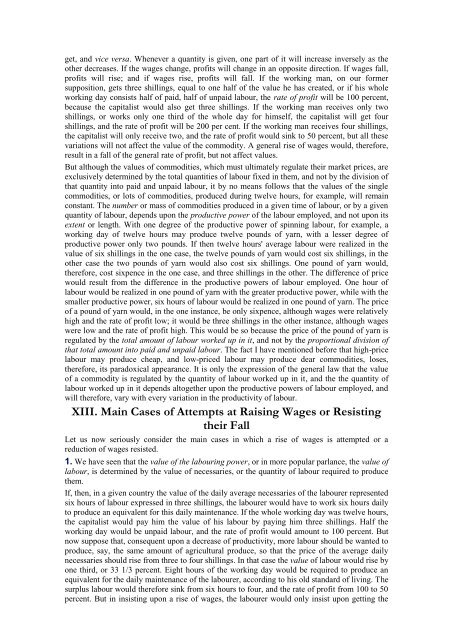




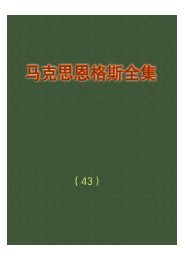
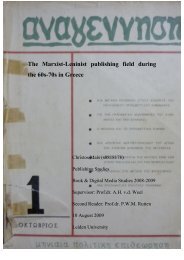



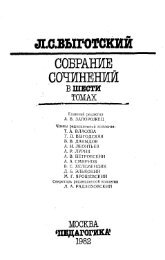

![tyf Enf=O=n]lgg](https://img.yumpu.com/47584932/1/190x245/tyf-enfonlgg.jpg?quality=85)
